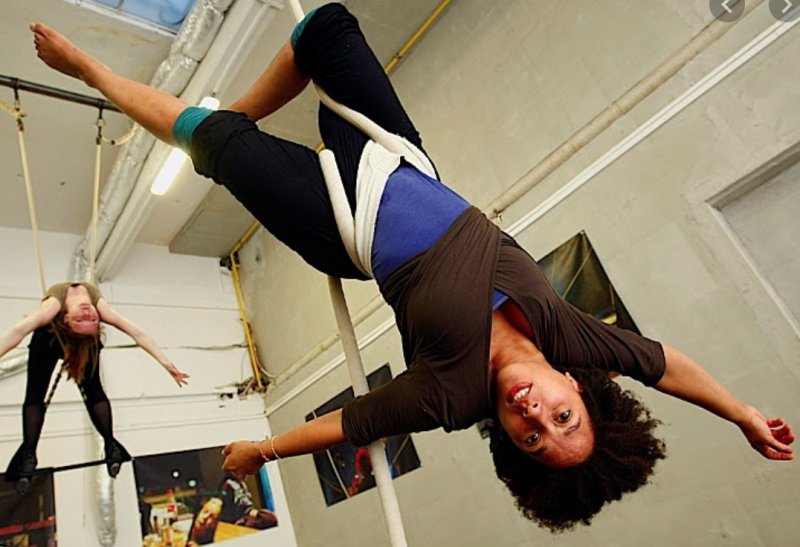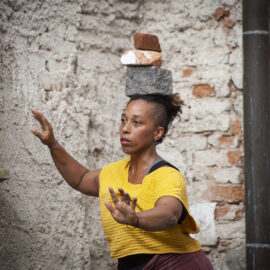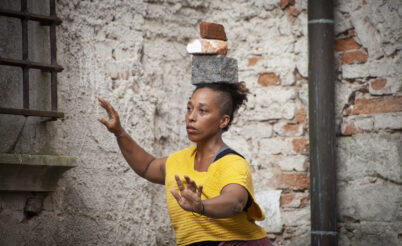
Šrámy/ la débattue
Artist, dancer, dramaturge and performer focusing her work on acrobatics and circus Stéphanie N’Duhirahe was this years resident in Žďár nad Sázavou. We asked her to write us more about her process of work during her stay in the castle.
Z: What was the main topic of the research or the creation during your Residency?
S: In the project Šrámy/ la débattue, I question the relation between body, remembrance and their connection with the pain. What is remembrance? What do we and what do our bodies hold from different stories of life? How can we speak about pain?
For this Residency, I particularly focused on the fact that the body remembers through generations. The main topic for this residency was Remembrance and pain linked to the History of Colonialism and Racism.
Z: What for a method you have chosen for your research or your creation?
S: This project is a site-specific project. The performance is built around the function of a specific place over a specific period of time so the show will always be a new experience and different stories will emerge from each time and place.
It is a project of living dramaturgy : I create different scenes (what i call sequences of life) in an unorganised manner, they could be used or cut out in function of the space and time. Everything could be changed. However, I use 2 elements as main tools for acrobatic and choreographic research : Ropes and Stones. These 2 objects will also help to link together the different sequences of life.
Z: What for a body you have chosen?
S: I work with the body linked to a specific space. I choose different spaces for specific reasons linked to the topic, and I let my body discover the space, move in it to try to understand it and find some connections. I worked also with the connection between body/Rope and body/stones.
Z: Were you working on the solo or group study or piece?
S: I was working on a solo which at the same time is not a solo : It can be performed by one or several artists depending on how I feel or depending on the place where it is performed. This project is an attempt to create an open performance structure which allows some hosting performers to create a new interpretation of an existing sequence including their own insight.
Z: In witch context?
S: During the time of this residency, I was working physically alone in the space, but for the reflection about the topic, I was collaborating in distance with the pedagog François NDuhirahe, my father, who wrote some texts about Remembrances which I use to create physical materials. I was also working in distance with the dancer Min Hieu Nguyen as consultant for the research of choreographic movement.
Z: Are you interested in interdisciplinary collaboration ?
S: Being myself an interdisciplinary performer (mixing in my practise, circus art, video art or performing art), I am really interested in interdisciplinary collaboration and it is a really important part of Šrámy/la débattue ; it is a collaboration with people from different backgrounds who can bring different perspectives to speak about this theme. (For example in this research, I already collaborated with the anthropologist and writer Hervé Munz and the sculptor Cécile NDuhirahe)
Z: In which phase of the process you have entered this Residency?
S: This residency offered me the possibility to dig deeper into the subject and to clarify what is important for me in this project. It was still the phase of reflection when you allow yourself to collect ideas, impressions, and sensations without thinking so much about a result. You let yourself be inspired by places, sounds, time and discussions.
Z: How did you like the work in the Castle, was the place inspiring for you?
S: It was very inspiring for my research to work in a place like the Castle of Zdar -such an important historical monument- . I have no doubt that this place is full of stories that, if we listen carefully, still resonate inside the walls. It is really the best place to speak about Remembrance, History/stories and pain.
Z: Was the frame of Cluster residency interesting from the networking perspective for you?
S: Yes I think the way the residency is organised, the support and discussions about our project really help to develop a project.

